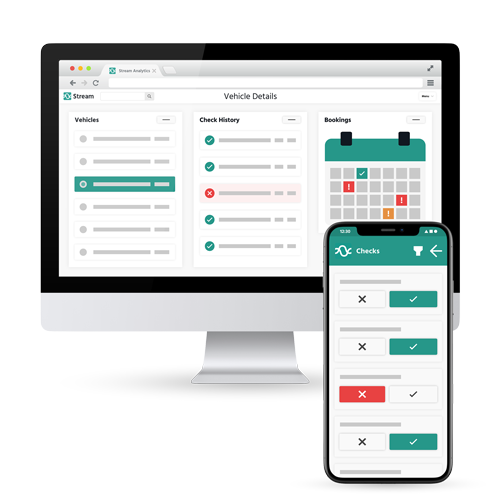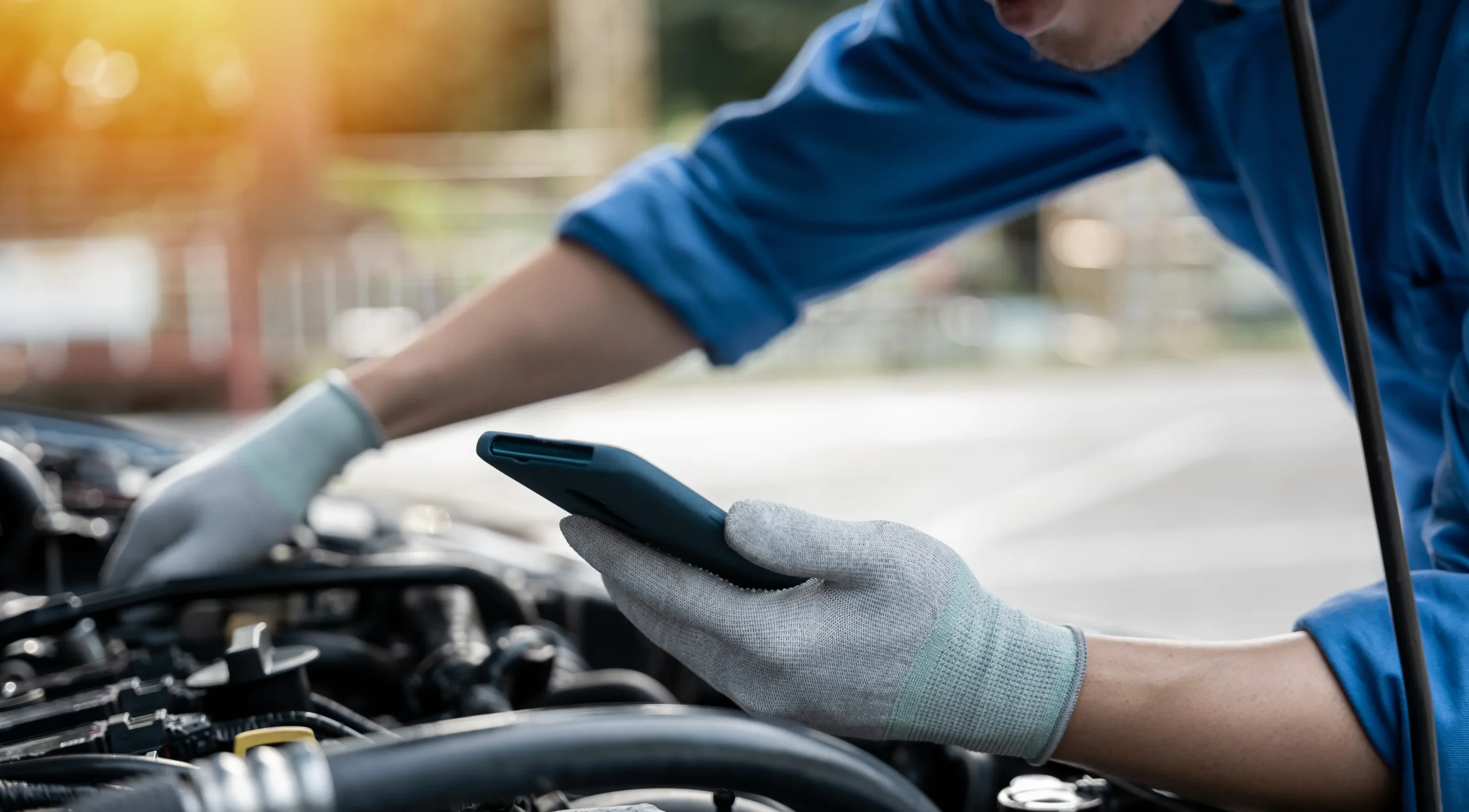The Guide to Maintaining Roadworthiness is the document provided by the DVSA, to guide operators of commercial goods vehicles and passenger carrying vehicles. The document offers guidelines and best practices for operators to comply with laws around vehicle safety and maintenance.
In other posts, we covered the sections of the guide relating to driver daily walkaround checks and regular & first-use checks. This post will explore the advice from the Guide to Maintaining Roadworthiness in relation to the use of electronic systems.
What does the guide say about using electronic systems to maintain compliance with safety checks?
Unlike guidance on check types (daily walkaround checks and regular & first-use checks), there was no specific section in the Guide to Maintaining Roadworthiness on the use of electronic systems until 2018.
The updated guide though includes a comprehensive section on electronic capture and storage of safety inspection data.
“Safety inspection and repair work records, whether undertaken by operators or contracted out, must be kept for at least 15 months as part of a vehicle’s maintenance history.
Operators must, however, ensure that the electronic records are complete and available, or can be made available on request for inspection at the operating centre. If you hire, lease or borrow a vehicle you are responsible for its roadworthiness and must have available, if required, copies of any inspections that have been carried out while the vehicle is in your possession”
Benefits of using an electronic system for vehicle maintenance:
The guide notes the ability to implement and manage an organised, efficient and well-planned system as a key benefit of using an electronic system can bring:
- Improve efficiency by giving you access to information about your fleet (including things like safety inspections, unplanned maintenance, inspection reports, driver defect reports and overall fleet management information)
- Link related data and technical information, so you can see maintenance history, scheduled repairs, and invoicing in one place
- Use this linked data to easily create dynamic maintenance schedules for each vehicle
Using an electronic system to check, record, report and store vehicle maintenance data, and to stay compliant with roadworthiness guidelines, actually has multiple additional benefits, for operators and for drivers including:
- Staying at the Forefront of the Sector – Implementing an electronic system now could put you a step ahead of the Earned Recognition scheme, and of any future changes to the guide that do require an electronic system as best practice
- Making Savings– You can cut your spend on the time and resources involved in managing and filing paper check sheets
- Increasing Accuracy – With an electronic system in place, you should be able to keep more accurate and secure records of all your checks
- Improving Completion Rates – Not only can you improve the accuracy of the checks undertaken, but you can also increase the likelihood of all checks being completed, with better monitoring and understanding of whether your drivers are adhering to the checks
- Streamlining the Vehicle Management Process – By combining results from daily walkaround checks and regular inspections, following issues through to resolution, and tracking key vehicle information (like registration details, classifications and MOT dates) in a single system
How to use electronic systems for vehicle maintenance and compliance
If the guidelines can be distilled into one simple statement, it would be this:
“It’s ultimately the roadworthiness of the vehicles operated that will demonstrate if the system is well designed and meets the required standards”
With operators and drivers holding equal responsibility for the safety of vehicles, you as an operator need to be satisfied that the systems and devices used contribute positively to the maintenance and safe running of your fleet.

The guide outlines some specific features which should be considered in the development of an electronic system. All the requirements below are fulfilled in Stream’s Walkaround Check feature:
- The availability of hard copies of records to be produced on request
- It must be tamper-proof (ie. records can’t be changed at a later date)
- It must be clear what’s been checked and by whom
- There must be a clear end-to-end audit trail
- Data file which covers all maintenance records for the fleet
- Fully electronic inspection records
- Collaborative digital planners
- Drivers walkaround check and defect reporting application
- Compliance dashboard
- Meet data protection requirements (including GDPR)
- Data back-up and disaster recovery system
Security & electronic vehicle maintenance systems
Ensuring the security of your data in electronic systems is essential, with enforcement action on the cards for non-compliant operators.
The guide suggests the use of security features like digital authentication through a login, date & time stamping and an audit trail – all of which Stream Check provides as standard.
Additionally, using a cloud-based system like Stream Check means that data security is improved. Contrary to popular belief (that anything stored outside an organisation is automatically riskier), cloud-based software is more secure than on-premise (and certainly more secure than paper files).
Temporary vehicles & electronic vehicle maintenance systems
Digital systems, as outlined in the guide, must be able to take into account and record the maintenance of any temporary or hired vehicles.
Stream Check’s flexible & scalable SaaS model makes it easy to adjust numbers with seasonal demand or business growth.
Data records & electronic vehicle maintenance systems
When a vehicle is sold, disposed of, or changes ownership, the original operator must still have access to records pertaining to the vehicle (whether digital or not).
Managing electronic vehicle maintenance systems
The operator is responsible for the regular administration, backups and safekeeping of data. By using a cloud-based system like Stream Check, your data is automatically backed up in real-time so it’ll never be lost – even if your internet connection is. The system is completely secure and compliant with GDPR regulations too.
Additionally, data must be easily accessible for management and auditing purposes, with some form of clear audit trail. As the software is accessed via a browser or mobile app, you and your staff are able to access your data in Stream Check at any time, from any location, using any device with a browser and an internet connection.
Use of electronic systems for driver daily walkaround checks
Driver daily walkaround checks can be completed using a handheld device with results stored digitally.

Drivers should always be able to produce at least the current day’s record at the roadside. The past 7 days of defect reports in Stream Check are stored locally on the device, so drivers are able to show their compliance whether or not they are in signal.
Systems should also include effective date and time stamping, as a way to ensure the reliability of data.
At a minimum, electronic systems must provide:
- A suitable method of digital signature
- Secure data input and storage
- Confirmation that the vehicle is in a roadworthy condition at the start of the journey
All of which is provided in the Stream Check driver daily walkaround app.
Alternatively, drivers could complete their checks on paper and then scan or photograph the check sheet to save digitally.
Use of electronic systems to record ad-hoc defects
The guide also encourages the use of electronic systems to record any ad hoc defects that happen whilst the vehicle is in use. Drivers are able to add a defect record during the day in Stream Check, reflecting all the requirements and information included in their daily walkaround checks.
Use of electronic systems to create a safety inspection programme
In discussing what the maintenance system needs to do, the guide states that:
“Any maintenance software should be developed in line with the maintenance schedule agreed as part of the operator licence requirements, and in consultation with this guide”
The flexibility to plan maintenance and booking schedules in line with your own vehicle and licence requirements is built right into Stream.
Planning inspections
Inspections should be planned at least six months in advance, with vehicles that are subject to statutory annual testing ideally planning a full year’s programme in advance, to avoid the duplication of services.
In addition to suggestions like a planner or flowchart, the guide notes that digital systems, like Stream Check, may be a good way to plan ahead. Digital planning systems for safety inspections and vehicle maintenance must follow the guidelines for scheduling regular checks, and additionally must:
- Be capable of providing records in ‘real time’ to the operator
- Include an audit process that shows date and time stamping
Which are both part of the key functionality included in Stream Check.
Completing inspections
Electronic devices can also be used to collect and store inspection details.
When storing and collecting inspection records digitally, the record must show a complete audit-trail from the inspection to the final sign-off of the vehicle after any repairs, and must also include the ability to declare whether or not the vehicle is fit-for-service.
Completing inspection reports
Each safety inspection for each vehicle must have its own separate inspection record. No matter how the inspection is originally recorded – whether electronically or with pen & paper – if it will be stored digitally, as it is in Stream Check, there is no need to retain the original check sheet.
Capturing & storing inspection data
If inspection data won’t be captured using a mobile device, operators can use barcodes or scanners for this purpose.
Stream Check complies with the requirements, as set out in the guide, for digitally stored inspection records. These records must be:
- Tamper-proof
- Capable of producing hard-copy information where required
Do operators have to use an electronic system to stay compliant?
On one hand, there is no requirement in the Guide to Maintaining Roadworthiness for using an electronic system. But it may only be a matter of time.
Earned Recognition is the scheme which will allow operators to share compliance records with the DVSA, in order to achieve the ‘Earned Recognition’ status. Earned Recognition will act as a mark of excellence and result in benefits for operators and drivers, like fewer roadside inspections. The Earned Recognition scheme does include a requirement for using an electronic system.
Judging by this requirement already in place for operators hoping to achieve the ‘gold standard’ in vehicle maintenance with earned recognition, and by major advances in technology over the past few years (both in the transport sector and more broadly), it would probably be safe to predict widespread adoption of electronic systems for vehicle maintenance and roadworthiness over the next few years.
Stream Check vehicle & fleet management software can assist operators in maintaining roadworthiness. Talk to us about managing your fleet maintenance by scheduling your demo today.








